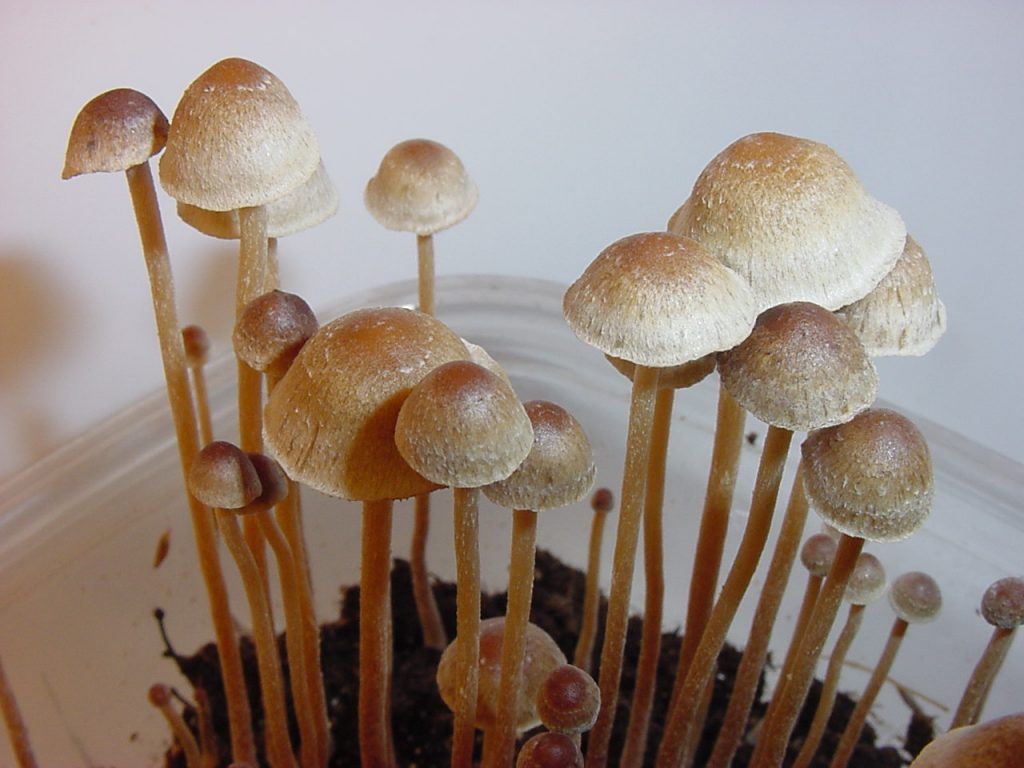Psilocybe tampanensis[i][ii] is one of several psychoactive mushroom species that also produce what are popularly knows as magic truffles. Now, true truffles are basically underground puffballs—they are spore-producing organs. Magic truffles, in contrast, are structures technically known as sclerotia that do not produce spores and instead store energy for the fungus. If drought or some other problem forces the mycelium to die back, the sclerotia will be able to survive in a dormant state and them generate new mycelium when conditions improve. In psychoactive fungi, the sclerotia as well as the mushrooms contain psilocybin, though not necessarily at the same potency.
P. tampanensis is widely cultivated for both its mushrooms and its sclerotia, despite the practice being illegal in most areas.
As the name suggests, this is a species originally discovered near Tampa, Florida. It’s not common, and often fruits single or in scattered groups, so it was a very long time before anyone found and documented any more specimens, but the species is actually widespread across the subtropical part of North America.
Identification & Description
Cap: Small, initially conical, then opening out to more or less flat with maturity, light orangish or yellowish brown with some blue at the edges. The interior flesh is whitish but bruises blue.
Gills: Partially attached to the stem, brown to purple brown with pale edges. In young specimens, the gills are covered with a cobwebby veil.
Stalk: Longish, proportionately, and thin, close to the same color as the cap.
Spores: Lemon-shaped.
Spore Print: Purple-black.
Smell: Vaguely flour-like.
Taste: Vaguely flour-like
Edibility: Psychoactive, but otherwise not considered toxic.
Habitat: Not known.
Range: Probably throughout the subtropical part of the southeastern United States.
P. tampanensis is probably more common in cultivation at this point than in the wild, so your chance of finding and identifying it in the field is probably pretty small.
Look-Alikes
P. tampaensis is part of a small tangle of between two and four species that are difficult to sort out without genetic testing. The very fact that the number of species in the group isn’t clear should be telling.
But most “little brown mushrooms,” or LBMs, look similar to each other. This group includes other psychoactive mushrooms, such as other Psilocybes and many members of the Panaeolus genus, but there are also culinary members of the group and some dangerously poisonous members, notably the aptly-named Deadly Galerina (Galerina marginata), which has killed people who thought it was a magic mushroom.
It’s not that LBMs are all identical, they’re not. Spore color, the presence or absence of a ring, the texture of the top of the cap, details such as these can usually nail down an identification properly—or at least get it pretty close. The problem is the temptation to neglect the meticulous process of keying out a species in favor of “hey, that looks about right.”
And that’s when people die.
Benefits
The benefits of P. tampaensis are those of psilocybin, and thus are essentially the same as all other psilocybin-containing mushrooms. Curiously, it’s a little hard to be sure what those benefits are.
That many people enjoy using psilocybin is undeniable. In addition to famously causing hallucinations (though actually these are typically subtle except at high doses), psilocybin usually brings on euphoria, feelings of connection, and interesting and useful insights. Many people incorporate psilocybin in a spiritual or personal growth practice, and it has been used religiously in some cultures.
But it is also supposed to help treat a long list of maladies from anxiety and depression to headaches and epilepsy, and there are various practitioners offering various versions of psilocybin therapy. Unfortunately, because psilocybin use is illegal in most jurisdictions, it is difficult to conduct clinical research on these uses, so we really don’t know yet how reliable –or safe—they may be.
Toxicity, Safety, and/or Side-Effects
The side-effects of P. tampaensis are also those of psilocybin. The most common of these, excessive yawning and nausea, are not a serious concern. A more problematic side-effect, extreme anxiety, sounds rather counterintuitive for a substance sometimes used to treat anxiety, but is seems as though psilocybin exaggerates whatever mood the user has. Go in feeling grounded and mellow, and you’ll have a pleasant trip. Go in nervous, or get frightened by the trip itself, and you’ll have a nightmare. The chance of a bad trip can be lessened by carefully preparing for the experience, ensuring a calm mindset and a safe setting, and being careful not to take too much. With practice, experienced psychonauts are even able to accept the anxiety and use it to work through difficult emotional blockages.
However, especially at higher doses rare but severe side effects are possible. These include balance and coordination problems and even convulsions.
It’s a good idea to not trip without a sober companion, not just in case of untoward side effects, but so that if you decide to go out to a park or something somebody sober can drive.
Anyone who eats psilocybin mushrooms by accident should be treated for mushroom poisoning, as an unwanted trip could be terrifying, especially for a child or a pet.
It’s also worth noting that one dangerous side-effect of psilocybin use could be arrest and prosecution. Know the law in your area and avoid being sent to prison.
References:
[i] Barlow, C. (2021). The Tragic Story of Magic Truffles: The Elusive Wild Psilocybe. Double Blind



